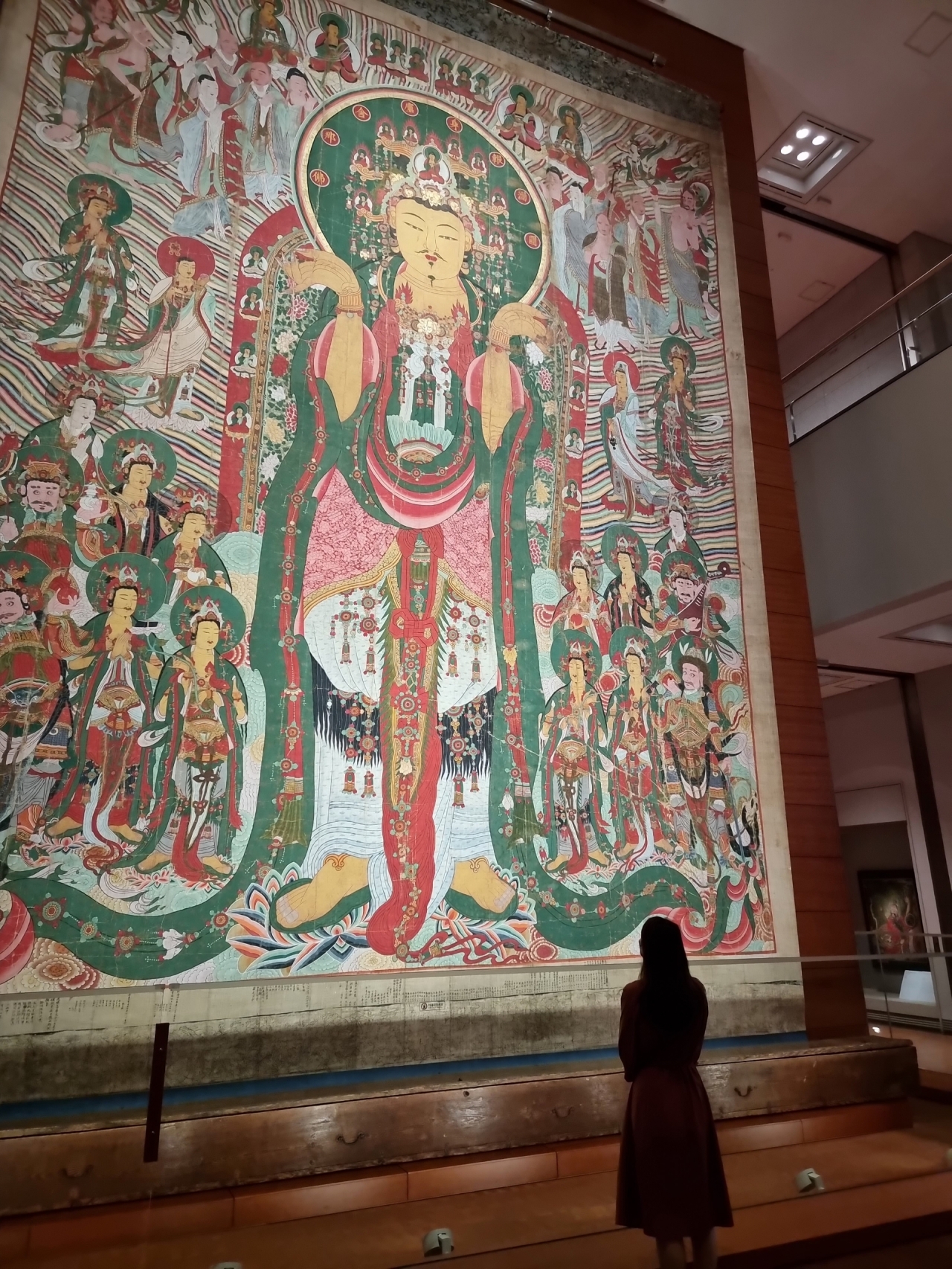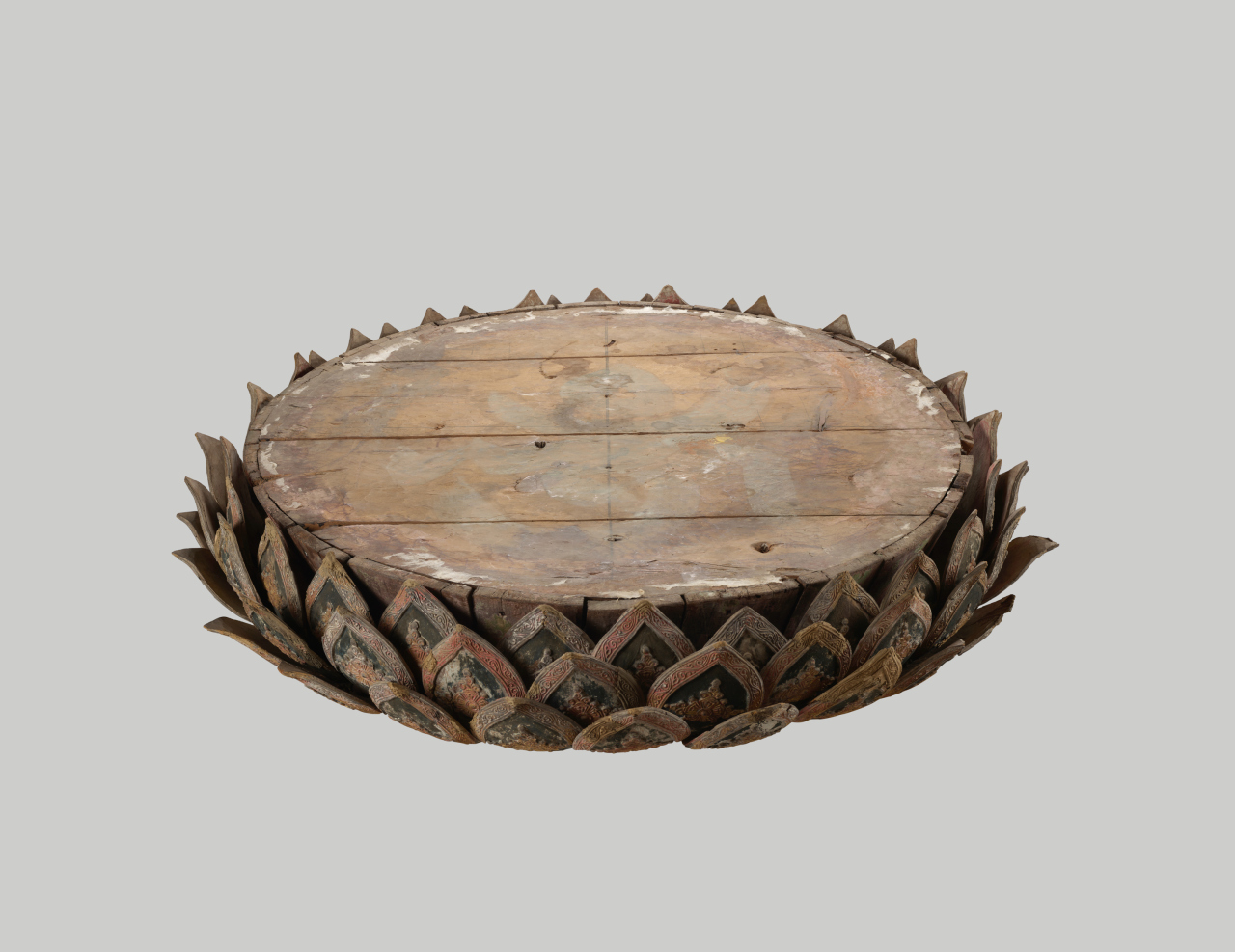National museum showcases massive painting to mark Buddha’s birthday
By Kim Hae-yeonPublished : April 12, 2022 - 14:16

National Museum of Korea is marking Buddha’s birthday with a special exhibition, “Feast of Light,” which opens Wednesday. This year, Buddha’s birthday falls on May 8.
The highlight of the exhibition is a large-scale 17th-century scroll painting featuring Rocana Buddha from Sudeoksa, a Buddhist temple in Yesan, South Chungcheong Province, and a 14th-century Goryeo-era wooden lotus pedestal. Both are state-designated treasures.
Gwaebul refers to very large Buddhist banner paintings. Typically, these large paintings were kept in storage and only taken out to be hung on special occasions, such as Buddha’s birthday. Those made during the Joseon era when Buddhism was under persecution by the ruling class who followed Confucianism, depicted spiritual practice and abstinence. Most gwaebul depict multiple divine figures gathered around the principal Buddha in a colorful and stylized manner, emphasizing Buddha’s presence at the center.
Rocana Buddha is one of the three bodies of the Buddha. Referred to as the “Blissful Body of the Buddha,” Rocana symbolizes immeasurable peace and happiness rewarded for spiritual practice and benevolent behavior.
The Yesan Sudeoksa Gwaebul of Rocana Buddha measures some 10 meters in height and 7.4 meters in width. It weighs over 150 kilograms.
The artwork was painted by monks in 1673 and has been used at outdoor worship services and ceremonies at Sudeoksa in Yesan.
The temple was founded in the sixth century during the Baekje Kingdom period. Sudeoksa’s main hall, Daeungjeon, a state-designated national treasure, was built in 1308 during the Goryeo period, one of the oldest wooden structures in Korea with a known date of construction.
Yesan Sudeoksa Gwaebul is characterized by light radiating in colorful waves from Rocana Buddha placed at the painting’s center. The gigantic Buddha, wearing a crown and robe of floral design adorned with colorful jewelry and beads, is surrounded by several bodhisattvas and disciples.
“For the exhibition, Sudeoksa monks carried the scroll stored in a wooden box, which together weighed over 380 kilograms,” NMK researcher Yoo Soo-ran told The Korea Herald, to the truck that would transport the artifact to Seoul. Yoo emphasized that the special exhibition will be a rare opportunity to see a Joseon-era gwaebul of such overwhelming size at the center of Seoul.
The highlight of the exhibition is a large-scale 17th-century scroll painting featuring Rocana Buddha from Sudeoksa, a Buddhist temple in Yesan, South Chungcheong Province, and a 14th-century Goryeo-era wooden lotus pedestal. Both are state-designated treasures.
Gwaebul refers to very large Buddhist banner paintings. Typically, these large paintings were kept in storage and only taken out to be hung on special occasions, such as Buddha’s birthday. Those made during the Joseon era when Buddhism was under persecution by the ruling class who followed Confucianism, depicted spiritual practice and abstinence. Most gwaebul depict multiple divine figures gathered around the principal Buddha in a colorful and stylized manner, emphasizing Buddha’s presence at the center.
Rocana Buddha is one of the three bodies of the Buddha. Referred to as the “Blissful Body of the Buddha,” Rocana symbolizes immeasurable peace and happiness rewarded for spiritual practice and benevolent behavior.
The Yesan Sudeoksa Gwaebul of Rocana Buddha measures some 10 meters in height and 7.4 meters in width. It weighs over 150 kilograms.
The artwork was painted by monks in 1673 and has been used at outdoor worship services and ceremonies at Sudeoksa in Yesan.
The temple was founded in the sixth century during the Baekje Kingdom period. Sudeoksa’s main hall, Daeungjeon, a state-designated national treasure, was built in 1308 during the Goryeo period, one of the oldest wooden structures in Korea with a known date of construction.
Yesan Sudeoksa Gwaebul is characterized by light radiating in colorful waves from Rocana Buddha placed at the painting’s center. The gigantic Buddha, wearing a crown and robe of floral design adorned with colorful jewelry and beads, is surrounded by several bodhisattvas and disciples.
“For the exhibition, Sudeoksa monks carried the scroll stored in a wooden box, which together weighed over 380 kilograms,” NMK researcher Yoo Soo-ran told The Korea Herald, to the truck that would transport the artifact to Seoul. Yoo emphasized that the special exhibition will be a rare opportunity to see a Joseon-era gwaebul of such overwhelming size at the center of Seoul.

Meanwhile, the wooden lotus pedestal, which was removed from the temple for the first time ever for the special exhibition, dates back to the Goryeo period, when Buddhism was at its height.
It is decorated with three tiers of lotus petals that are each carved separately and attached along the side. The circular throne has rectangular wooden panels attached all along its side. Each lotus petal, with a bead design at the center, is trimmed with a scroll band along the edge. Traces of gilt can be seen on the relief ornamentations.
Other Buddhist artifacts shown at the exhibition include a series of replicas of murals found at the main hall of Sudeoksa. They depict a variety of flowers and plants including lotus, peonies, lilies and cockscomb, offering a glimpse of gardening traditions from the Goryeo era.
The exhibition will run through Oct. 16 at the gallery of Buddhist paintings on the second floor of the museum.
By Kim Hae-yeon (hykim@heraldcorp.com)
It is decorated with three tiers of lotus petals that are each carved separately and attached along the side. The circular throne has rectangular wooden panels attached all along its side. Each lotus petal, with a bead design at the center, is trimmed with a scroll band along the edge. Traces of gilt can be seen on the relief ornamentations.
Other Buddhist artifacts shown at the exhibition include a series of replicas of murals found at the main hall of Sudeoksa. They depict a variety of flowers and plants including lotus, peonies, lilies and cockscomb, offering a glimpse of gardening traditions from the Goryeo era.
The exhibition will run through Oct. 16 at the gallery of Buddhist paintings on the second floor of the museum.
By Kim Hae-yeon (hykim@heraldcorp.com)











![[Today’s K-pop] BTS pop-up event to come to Seoul](http://res.heraldm.com/phpwas/restmb_idxmake.php?idx=644&simg=/content/image/2024/04/17/20240417050734_0.jpg&u=)





![[KH Explains] Hyundai's full hybrid edge to pay off amid slow transition to pure EVs](http://res.heraldm.com/phpwas/restmb_idxmake.php?idx=652&simg=/content/image/2024/04/18/20240418050645_0.jpg&u=20240419100350)

![[Today’s K-pop] Zico drops snippet of collaboration with Jennie](http://res.heraldm.com/phpwas/restmb_idxmake.php?idx=642&simg=/content/image/2024/04/18/20240418050702_0.jpg&u=)